There is no lack of speculation when it comes to Naypyitaw, Myanmar’s exceedingly weird and purpose-built capital—
- Subterranean tunnels connect strategic buildings
- The location is a safe distance from the sea to thwart a potential American invasion
- Construction of the future capital depended on the advice of the military junta’s astrologer
- Massive highways double as potential runways in the event of a revolution
- North Koreans offered advice on planning and securing the phony megalopolis
Oddly fascinating and totally out of the ordinary, what a place this must be! Naypyitaw quickly rocketed to the top of my Myanmar must-visit list.
The generous city limits mean Naypyitaw’s creation from thin air in 2002 swallowed up several surrounding towns and villages. It is technically six times the size of New York City and larger than the entire state of Rhode Island. Just under a million people supposedly live here. In reality it feels like a town of perhaps ten thousand at most.
Whatever the actual reasoning behind Naypyitaw—literally “Abode of the King” in Burmese—it is surely one of the most peculiar cities on Earth.
WELCOME TO NAYPYITAW
My first taste of Naypyitaw came during a breezy motorbike ride from the shopping center that doubled as the minibus depot. Mr U found me before I even stepped foot off the minibus from Yenagyaung and thank Buddha for that. There is no public transportation in Naypyitaw and no one goes anywhere without their own ride.
I read about massive concrete boulevards connecting distant government offices and specific “hotel zones”, but nothing quite prepared me for cruising down extra-large byways virtually free of traffic.
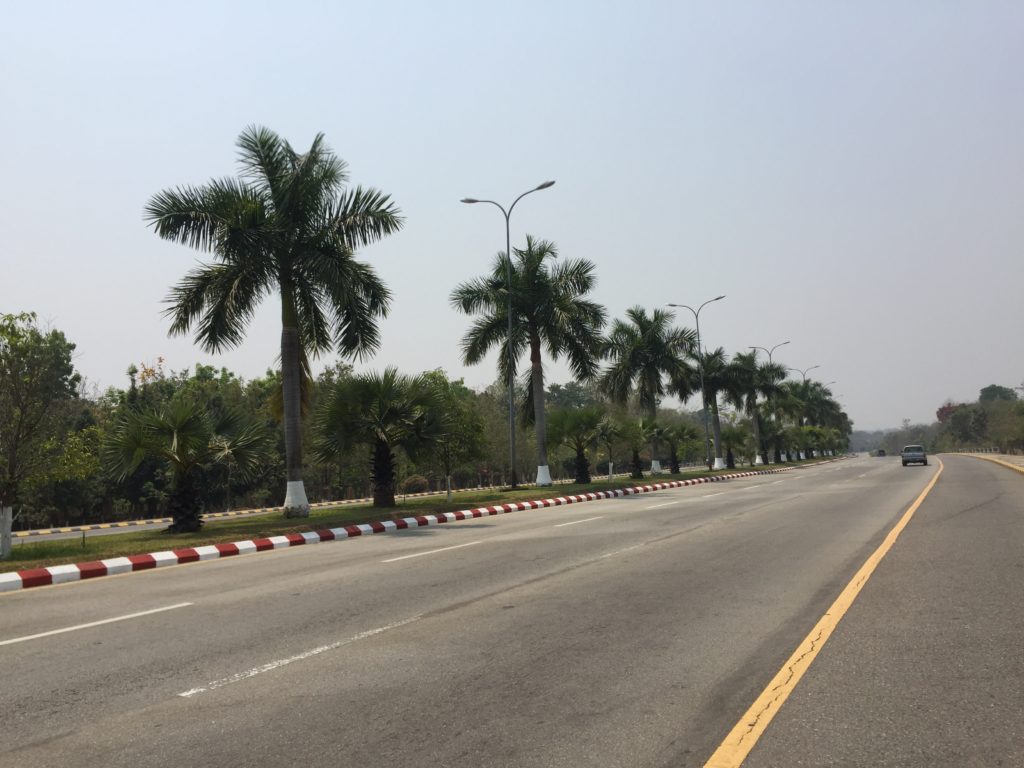
Since it had not rained for more than five months, the grassy medians were unnaturally verdant. Timed sprinklers and roving water trucks made magic happen in parched Naypyitaw. Small work crews cleaned up tree branches and leaves and tidied up already pristine public spaces. Colorful flowers dotted colossal roundabouts. Even the striped paint on the curbs was in top notch condition.
Twenty minutes in and Naypyitaw was pretty much the exact opposite of everything I had come to expect during fifty-six days over two trips to Burma.
A PALACE FIT FOR A GENERAL
I booked in at the Aureum Palace Hotel and Resort in Hotel Zone 1, ten minutes drive from what passes for the center of town.
Mr U’s motorbike bounded up the Aureum’s concrete driveway and stopped at a tiny security outpost. A pair of armed guards half heartedly flagged us down. They waved us on and quickly retreated to their stark white oasis amid the early afternoon blast furnace that is Naypyitaw in March.
We wove past carpets of technicolor green grass and dipped in and out of shadows cast by orderly rows of towering palm trees. Over a few speed bumps we went, straight to the covered entryway of the cavernous hotel.
Mr U and I agreed to meet up again around dinner.
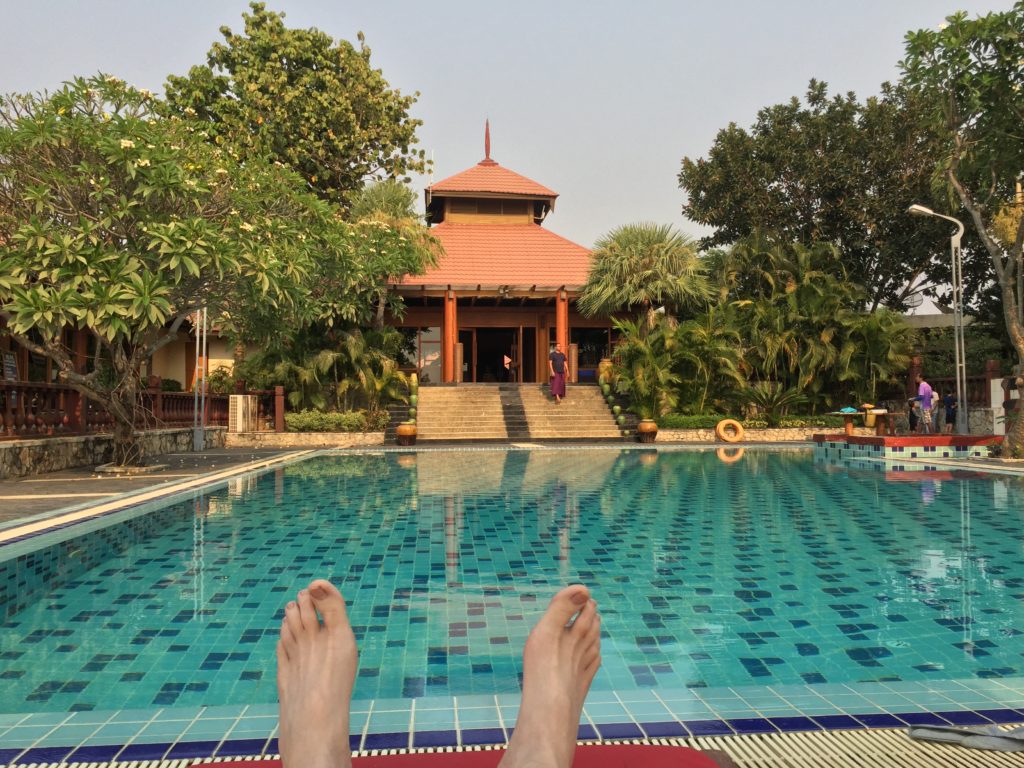
The hotel mirrored the city itself–immaculately landscaped, virtually empty and unnecessarily massive. Walking around the property was simply out of the question. A cheery staff member piloted a canopied golf cart that shuttled me to and from the pool.
Over two days at the Aureum I came across a grand total of ten guests. In fact, there were more people at the pool than appeared to be staying in the entire hotel.
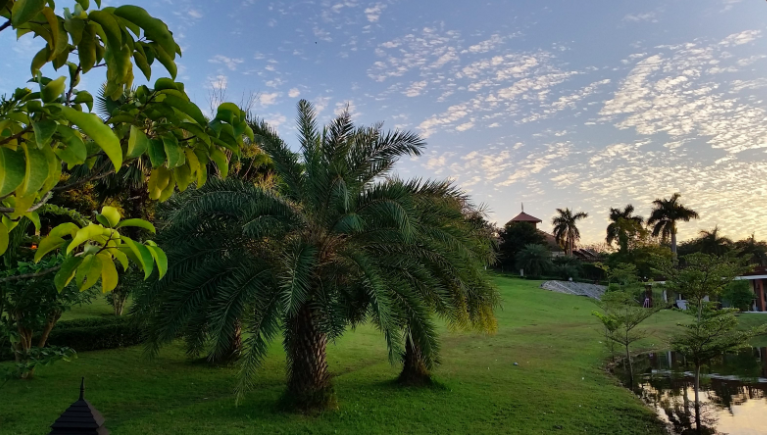
An attractive young mother in what could pass for a western style bathing suit shed some light on the opaque nature of life in Naypyitaw.
Enlightening fact number one–the Aureum Palace Hotel is owned by a retired Burmese military general.
See the accommodation section at the end of this post for important info regarding hotel ownership in Myanmar
Myanmar’s generals have pilfered state coffers over the decades to become wildly wealthy, especially by Burmese standards, so I use the term “own” loosely. The military is corrupt and has its collective mitts in a variety of industries from drugs to gems and timber. Many of the men who drove Burma to the brink of economic and social collapse have since retired to secure, gated compounds around Naypyitaw.
Somewhat like my hotel.
Military bigwigs and their families have access to the full range of the Aureum’s amenities. Turns out I happened upon the pool during a group lesson for the children of Naypyitaw’s privileged elite.
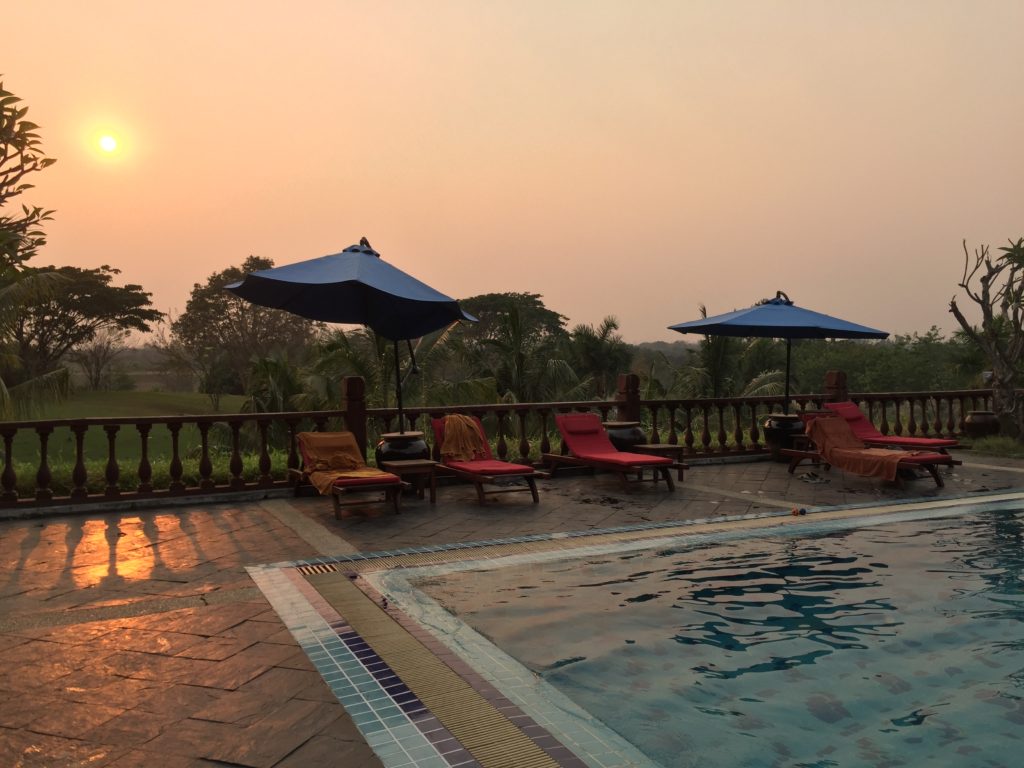
NAYPYITAW–ABODE OF THE KING
Mr U and I stopped for dinner at Maw Khan Nong, a Shan restaurant in what could generously be described as the center of Naypyitaw. Locals spilled out onto the green turf terrace and nursed cold bottles of Myanmar beer while others enjoyed the Arctic-level air conditioning inside near the buffet counter.
A bowl of delicious Shan noodles tallied just 500 kyat (US$0.33). Deep fried chicken balls in a tangy sweet and sour sauce arrived on a platter so large it covered my entire place setting. The meal-for-two, but-only-for-me rang in under 4,500 kyat (US$3).
Mr U sipped neon-colored fruit juice and spoke about his family and the changing face of Naypyitaw while I dined.
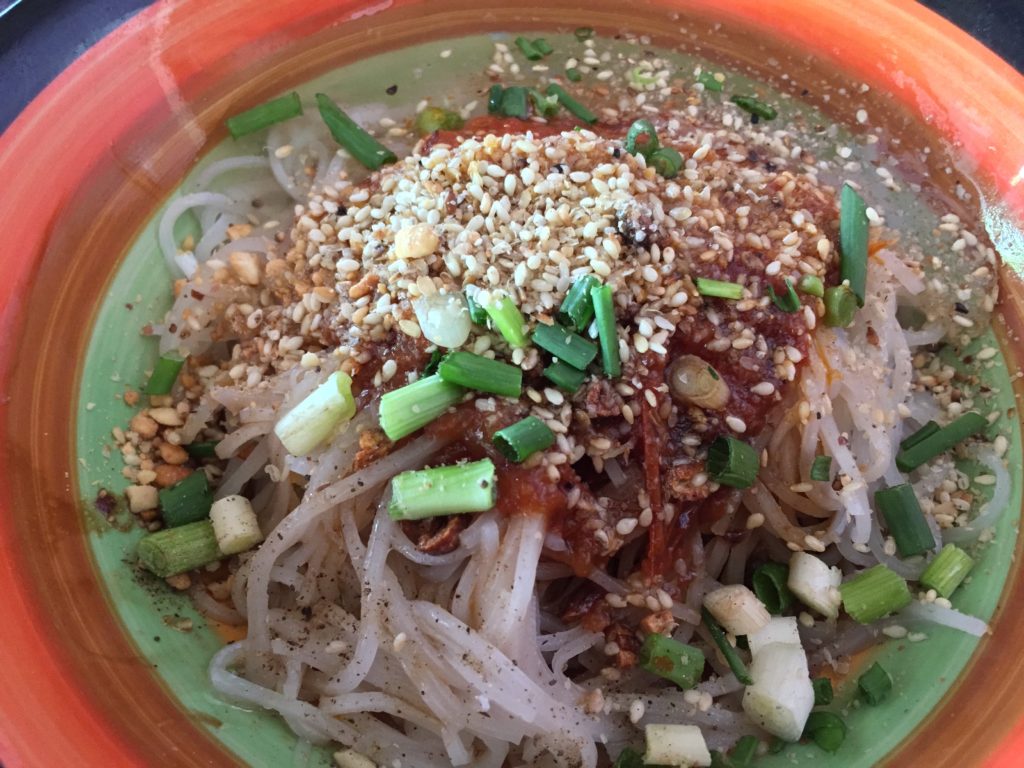
A lifelong local, Mr U grew up nearby, though not in Naypyitaw. The town itself only came to be in 2002. The generals settled upon the royal name (remember, “Abode of the King”) and quickly set about their vision. Construction on the faux metropolis began in earnest.
- 25 identical government ministries, each hidden at the end of a winding concrete driveway
- A 100-room presidential palace
- The Hluttaw, a gigantic 31-building parliament complex
- A new railway station–45 minutes drive from the center of town
- The National Museum, a Gems Museum, the Defense Services Museum, the National Library
- A brand new airport
- More than 60 hotels, guesthouses and resorts
- Several military bases
- Colossal highways to connect everything
Naypyitaw was basically built from scratch. Overall costs are murky, but speculation runs well north of $3-4 billion.
Myanmar’s generals transferred the seat of government as soon as the new capital began to take shape. Workers were given two months notice. Relocate from Yangon or find another job.
In addition to the necessary government infrastructure, Naypyitaw lacked another important feature–housing. The solution? A purpose-built Residential Zone, including twelve hundred, four-story apartment buildings with color-coded roofs. Ministry of Health employees moved into blue roofed buildings while Ministry of Agriculture workers moved into green roofed buildings. And so forth.
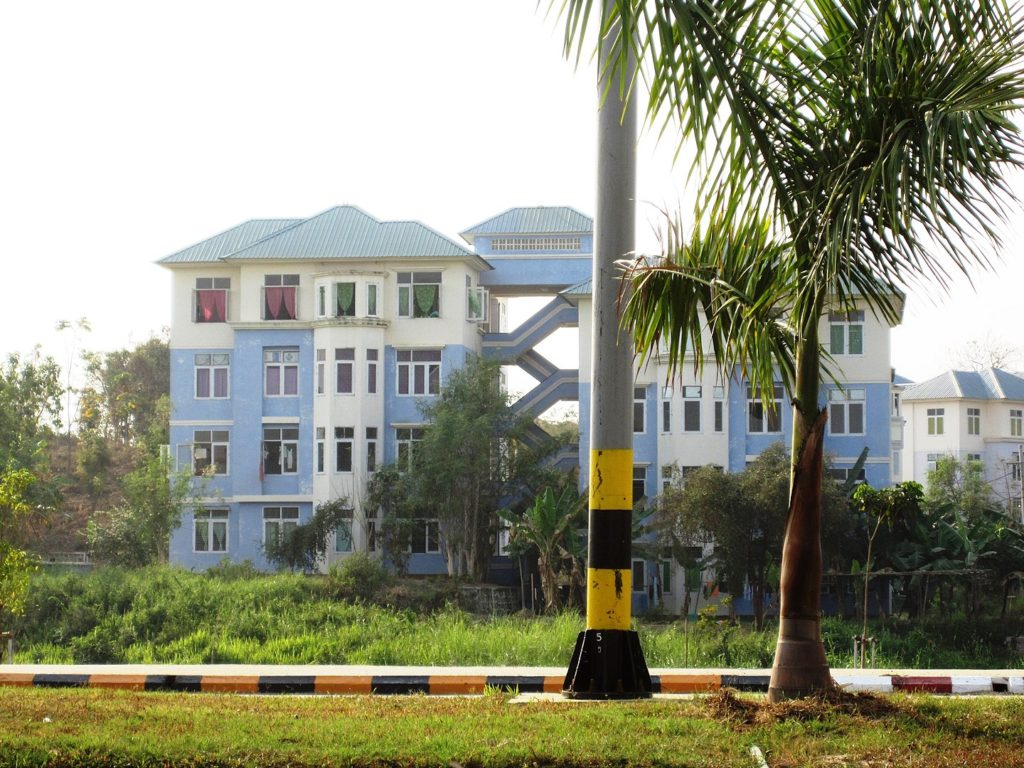
Naypyitaw, in a word, weird.
NAYPYITAW’S PEACE PAGODA–UPPATASANTI
Mr U and I continued on to Uppatasanti Pagoda, known locally as the Peace Pagoda.
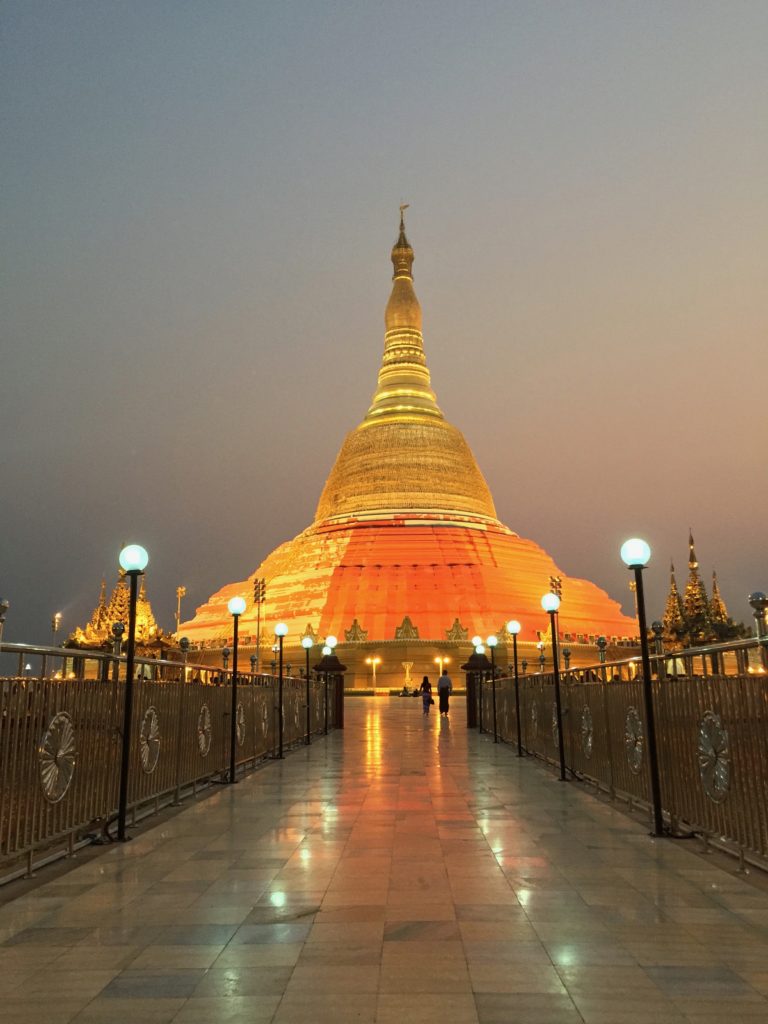
Uppatasanti is a merit-making project of the notorious former military number one, General Than Shwe. It can hardly be described as a symbol of peace.
Were the deaths of twenty locals during the pagoda’s consecration pure coincidence or emblematic of something deeper? Of Buddha’s smiting the Burmese generals and their vanity project?
The pagoda sits atop an elevated platform and utterly dominates the nearby neighborhood. Its eye-catching conical spire pokes above the trees and is visible long before arrival.
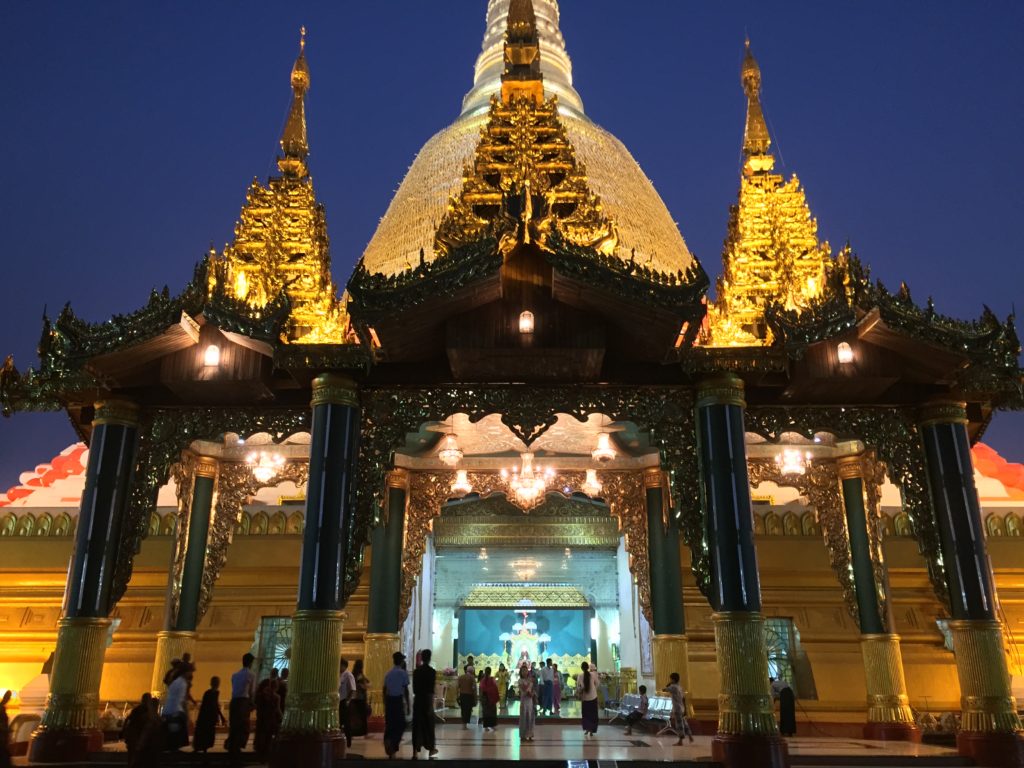
Uppatasanti’s golden stupa stands three hundred and twenty-one feet tall. It is a single foot shorter than the stupa of Myanmar’s cherished star attraction, Shwedagon Pagoda. The entire sight cuts a spectacular figure, especially after dark when the stupa glows like a star.
Its interior is home to a Buddha tooth relic and a series of intricately carved stone panels. Scenes from Burmese history and the life of the Buddha line the walls and encircle the hemispherical dome. Several neon-lit shrines front a central column where locals perform Buddhist rituals.
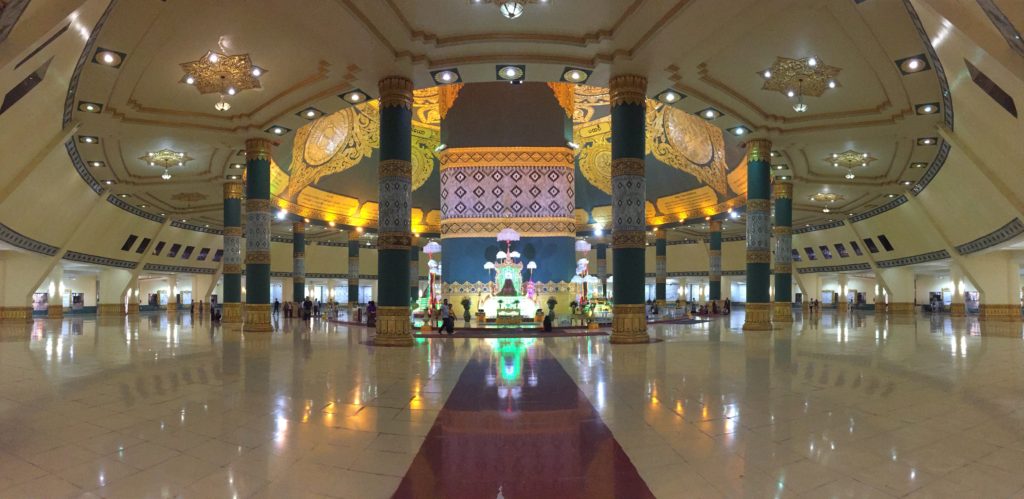
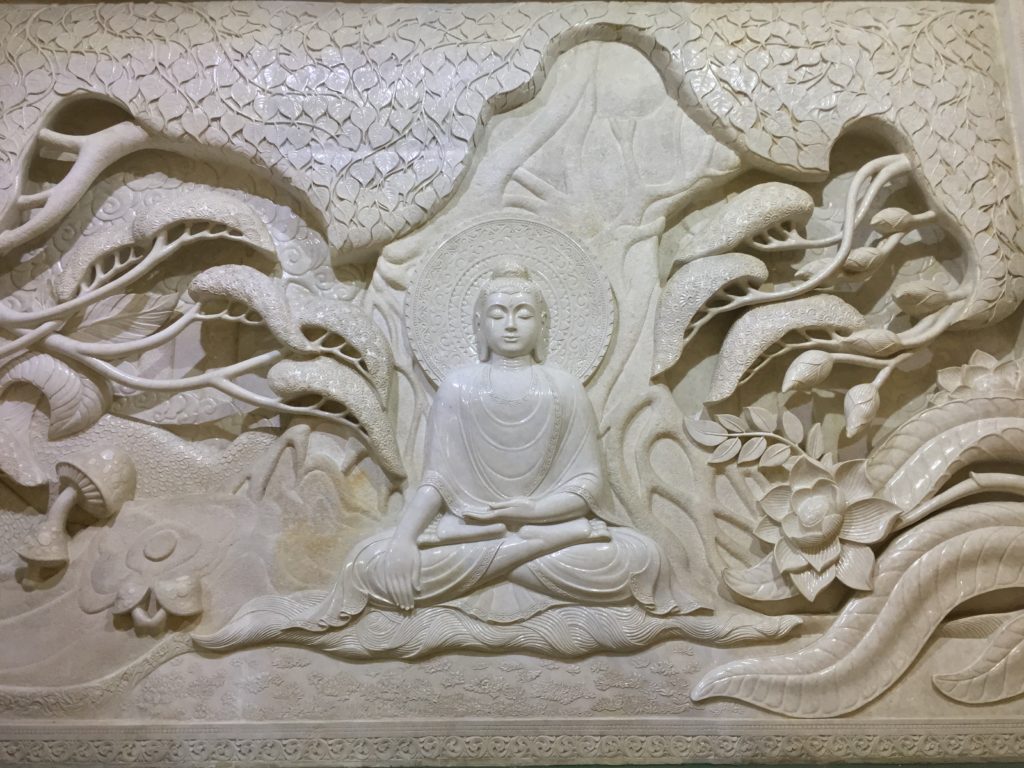
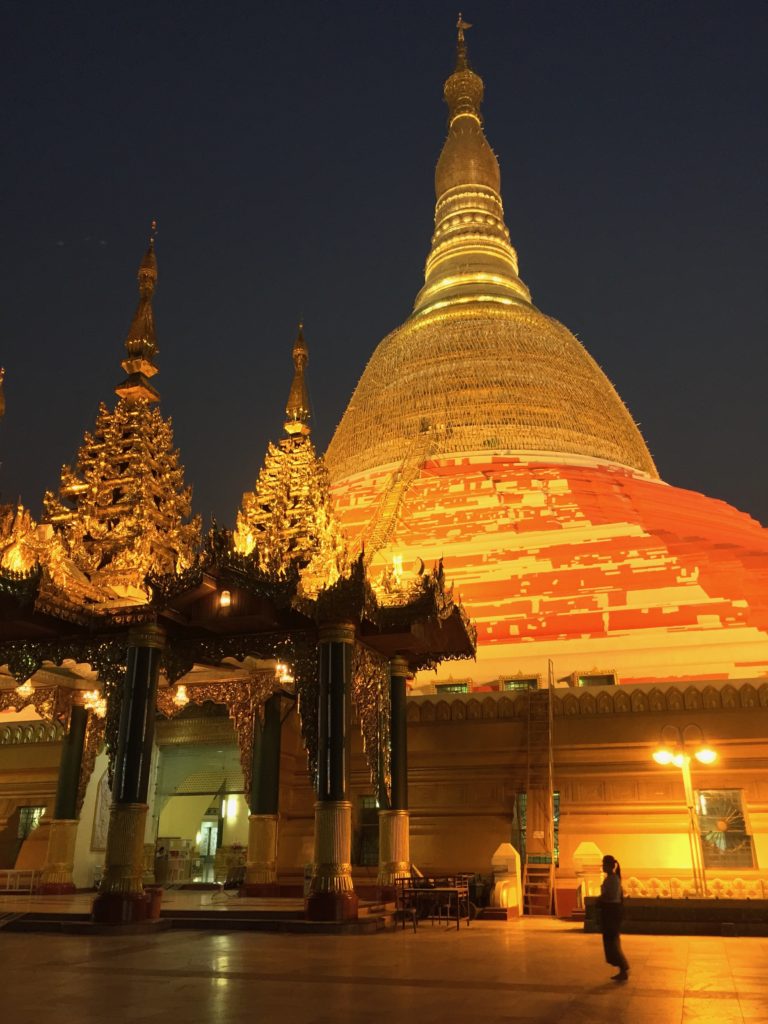
NAYPYITAW’S ALBINO PRISONERS
Across the street from the pagoda, the seemingly regal but exaggeratedly named Royal White Elephant Garden.
White albino elephants are revered across Southeast Asia. They stand as symbols of royal power and good fortune. In military dominated Myanmar, royal symbolism confers an air of legitimacy the generals have been unable to secure at the ballot box. So they believe.
This thorough article on the white elephants of Naypyitaw is a must read.
Burmese authorities scour the country with the sole purpose of trapping albino elephants. Their spirits are broken for a life in captivity before they are hauled to Naypyitaw.
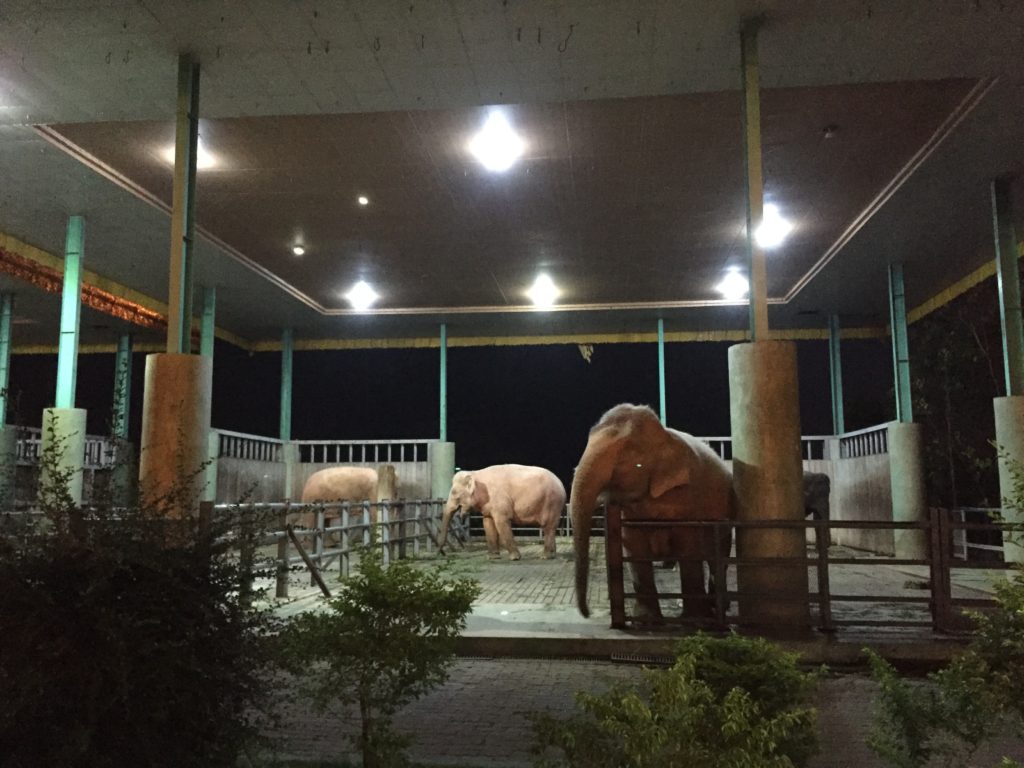
The captured elephants wind up in a tiled paddock facing the Peace Pagoda’s main entrance. The pink skinned albinos are chained up twenty-two hours per day, reduced to propaganda symbols. Harsh overhead fluorescent lighting belies the darkened sky and turns night into elephant day. Chinese tourists snap photos. Sadness hangs in the air.
I could barely stand to look them in the eye.
THE WATER FOUNTAIN GARDEN
More well-lit, 14-lane highways took us to the surprisingly pleasant Naypyitaw Water Fountain Garden.
Mr U and I strolled through a shell shaped pavilion where Burmese music videos projected onto a water fountain’s spray. Smaller fountains in the background danced to the music and changed colors with the beat.
Young boys in Manchester United football jerseys offered up perfectly accented ‘Hellos’ whenever our paths crossed.
A 5-story tower at the edge of the music’s reach allowed for sweeping views across the 165-acre complex.
Multigenerational families piled into rickety boats for a paddle around the artificial lake below. Novice monks in maroon robes goofed around on the adjacent playground. Young couples walked hand in hand and enjoyed ice cream cones.
The park was full of manmade walk-behind waterfalls and pedestrian foot bridges, group selfies and uproarious laughter. There were snack stands piled high with deep fried Burmese treats and drinks vendors surrounded by stacks of fruit.
On the whole, the park’s humanity and simple, everyday fun brought a dose of much needed life to notoriously sterile Naypyitaw.
The only thing missing from the Water Fountain Garden? Tourists. I didn’t see a single one.
THE 20 LANE HIGHWAY
Early the following morning we headed toward Naypyitaw’s pièce de résistance of weird—the world renowned 20 Lane Highway.
Up and down gently sloping hills and around tree lined bends we went, deep into the Ministry Zone. Alternately painted red and white curbs edged either side of the road and stretched off into the distance. Government ministries popped up every few hundred meters. Massive pillars marked the entries in both Burmese and English, but Mr U called out each one as we cruised past.
The Ministry of Immigration and Population.
Wind whipped through the ear holes of my helmet as I angled for a glimpse of life beyond the endless driveways.
The Ministry of Social Welfare, Relief and Resettlement.
Several workers gathered fallen palm fronds while others dragged water hoses across unnaturally green lawns.
The Ministry of Religious Affairs and Culture.
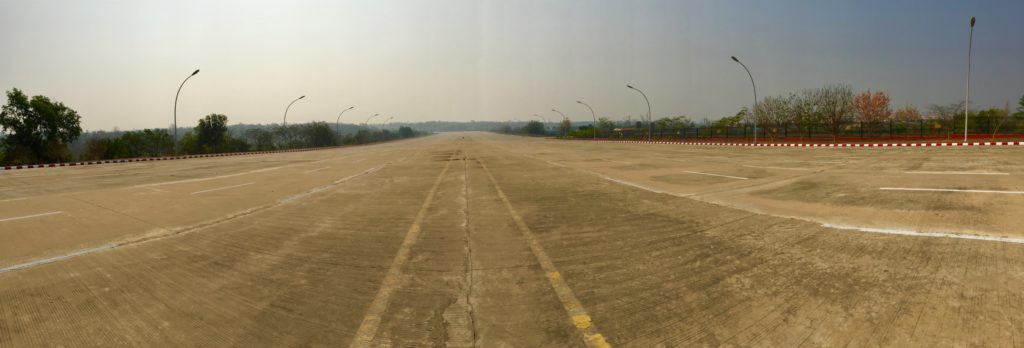
There are two sections of equally ridiculous 20 Lane Highway in Naypyitaw. The more intriguing segment runs adjacent to Myanmar’s Hluttaw, the large parliament complex.
Mr U pulled over to the curb and gave a quick head turn. With the all clear, he began to pilot the motorbike in a sweeping arc across the entire road. We counted the lanes aloud together as we inch-wormed across the runway, er, road.
Six, nine, eleven.
Fourteen, eighteen.
Twenty!
The highways-as-runways speculation? Easy to understand from ground level.
Vehicles are barred from stopping on the highway, so Mr U and I instead parked at the T-intersection nearby and walked. Tiny wooden shacks dot the center of the highway and act as outposts of enforced order, but they were empty on a Sunday morning. Traffic was not quite non-existent, but in no way shape or form did it merit even a few lanes in each direction, let alone ten.
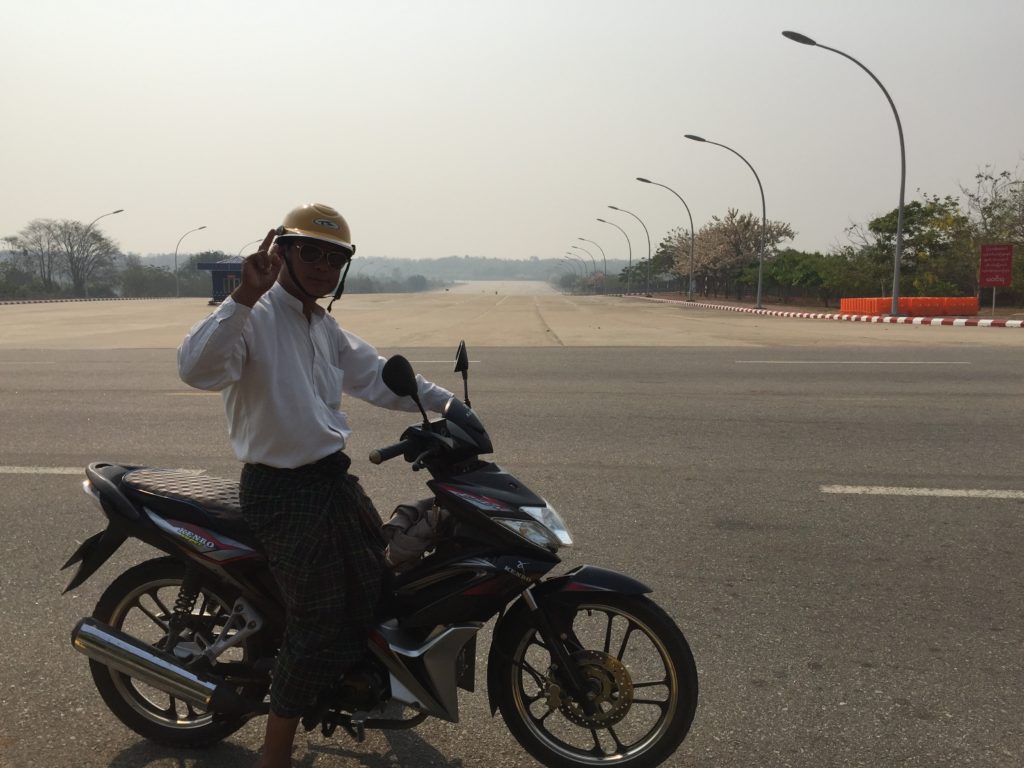
I walked straight down the center of the highway and spun around in awe.
Imagine three interstate highways laid side by side, pluck virtually every single vehicle from the lanes, then go for a stroll. It doesn’t get much more odd. Or awesome.
THE NATIONAL MUSEUM
Despite living locally his entire life, Mr U had never been to the National Museum. That fact shocked me initially, but then I realized the museum has only been open since 2015.
We paid the museum a visit after a morning spent cruising Naypyitaw’s highway and byways.
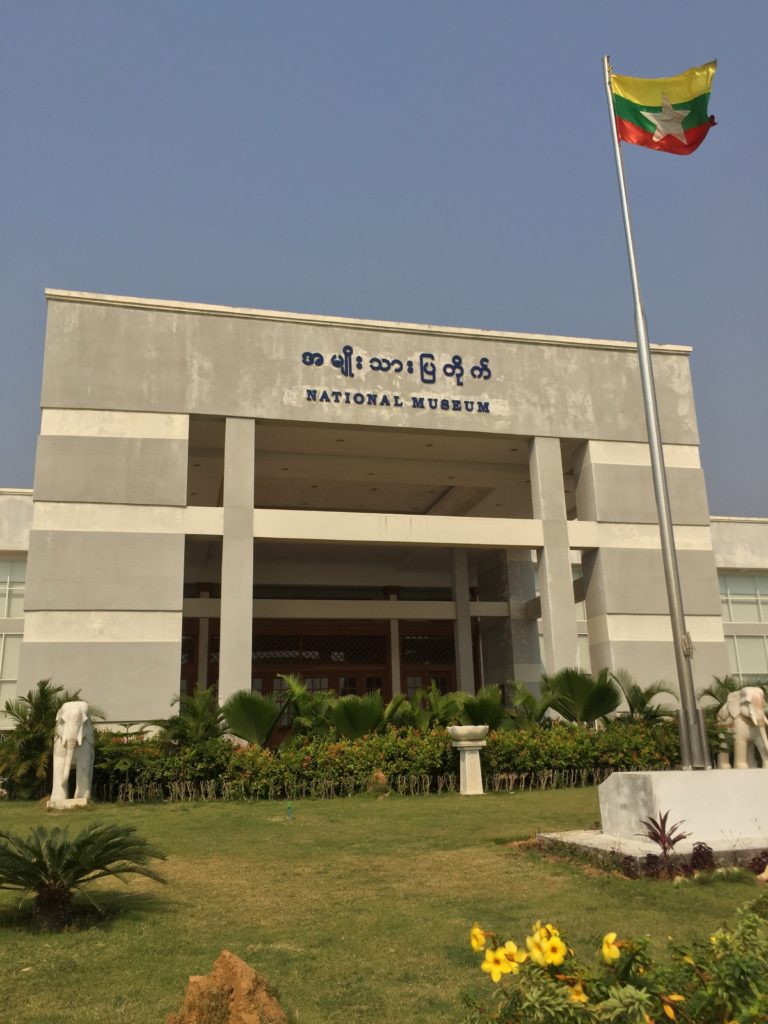
Local entry fee runs 500 kyat (US$0.33) while foreigners pay ten times that, 5,000 (US$3.33). A friendly girl with yellow thanaka dabbed cheeks settled our tab. She handed over an obscenely large brochure and, in typically friendly Burmese fashion, pointed out the location of the best displays.
I love a good museum wander, but the highlight had to be watching Mr U soak in his own national treasures. The gilded and bejeweled throne of the last Burmese king just about sent his mouth to the floor in wonder. In another room, we caught eyes across a display of dazzling betel nut spittoons and exchanged smiles and thumbs ups.
Informative exhibits on Burmese history and culture and plentiful English labels made for a pleasant few hours.
NO SAY BAH NE, NAYPYITAW
Mr U and I made our way to Naypyitaw’s train station later that evening. Along the way we passed Uppatasanti’s shimmering stupa, then we detoured to the second stretch of 20 Lane highway, this one fronting a heavily guarded Burmese military base. We wove through a series of smaller towns that were absorbed into Naypyitaw upon the capital’s creation. Technically, they no longer exist.
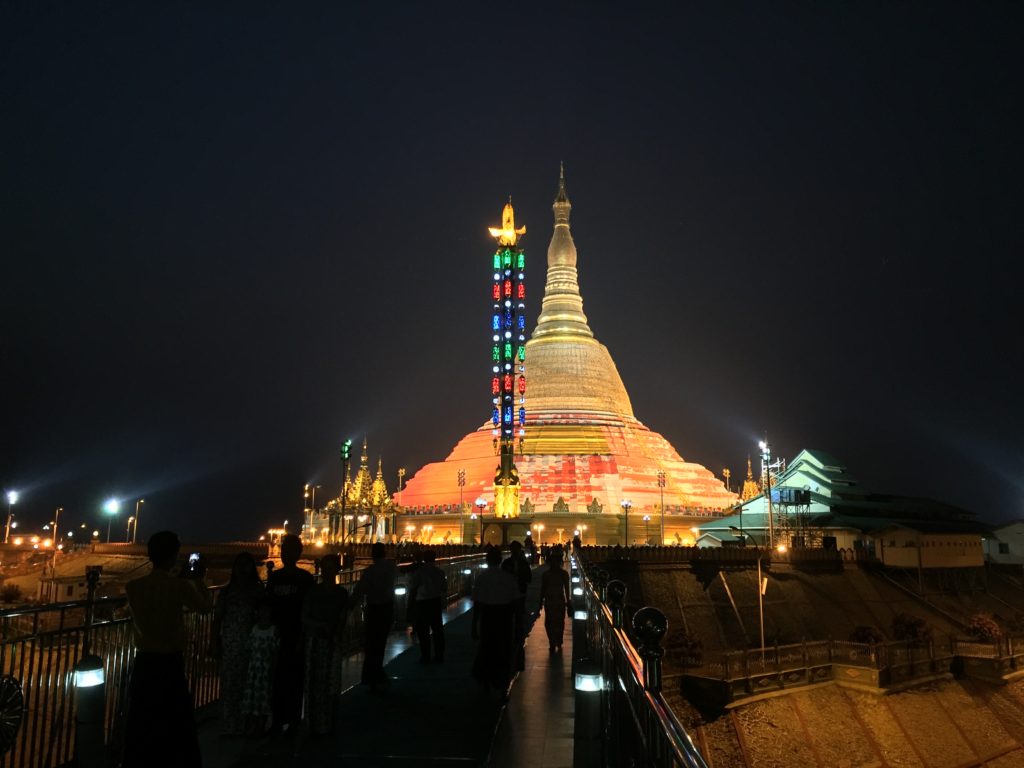
Once at the station Mr U wouldn’t let me carry my backpack. He literally wrestled it from my hands. Inside, a smiling Myanmar Railways manager extended an invitation to his office and considered my request for a ticket to Yangon.
There were no sleeper berths available.
The night train to Yangon originates in Mandalay, so it wasn’t much of a surprise.
No upper class seats either. Now that was a surprise.
“Only ordinary class.”
Traveling life doesn’t get much better than Myanmar’s diesel trains, but this would be my first ordinary class sleeper experience.
I bought the 2,800 kyat ticket (US$1.85) and settled in before departure.
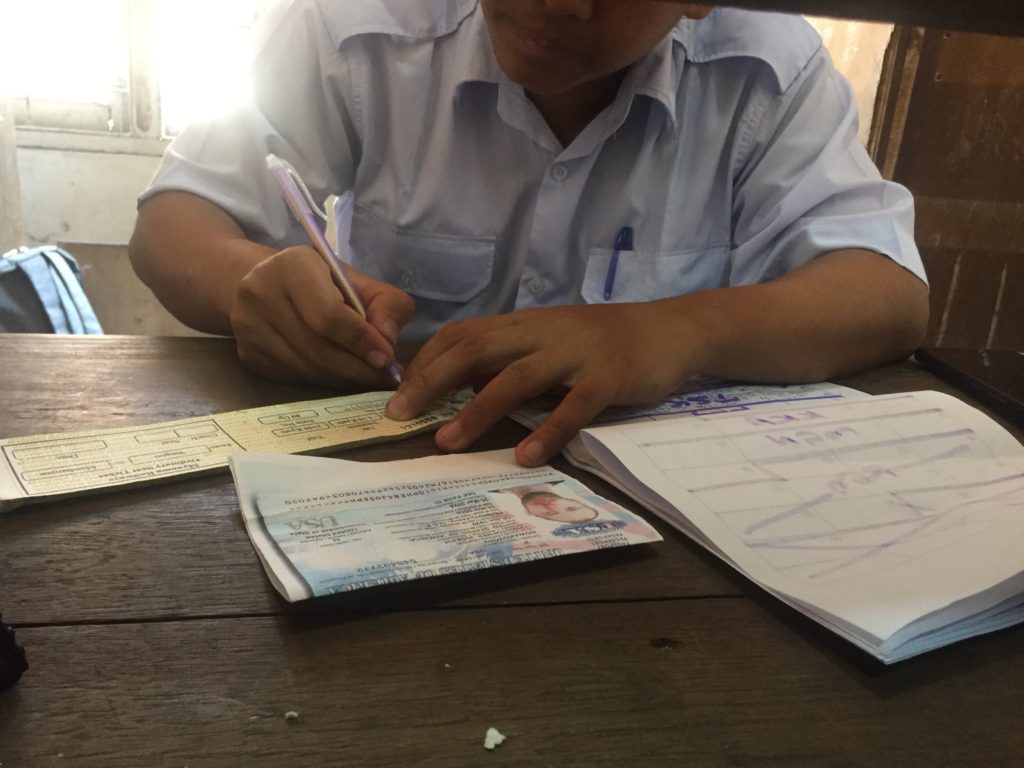
Despite the late hour, Mr U refused to leave my side until the train’s arrival. He introduced his moto taxi friends, then explained my existence in painstaking detail. I was gifted a bottle of water for the journey. The guys told me, in no uncertain terms, to contact Mr U upon my return to Naypyitaw.
I promised I would.
We exchanged warm goodbyes as the train screeched to a halt. I climbed up the steps and searched for seat number eight at the far end of the carriage.
When I got there, Mr U and his friends were standing outside the window.
******
A peculiar history, huge 20 Lane Highways, sanitized streets and undercurrents of military rule. I had difficulty wrapping my head around what was going on in Myanmar’s capital.
Naypyitaw is definitely weird, I thought to myself.
But as with every other destination in Myanmar, an old axiom holds true–the people make the place.
DO IT YOURSELF
It’s easy to get to Naypyitaw–most visitors simply don’t bother.
Myanmar’s capital sits virtually dead center in the middle of the country. The Yangon/Mandalay Expressway is just a few miles west of town while the railway line is a bit further east.
Naypyitaw was built for government business, not tourism, so keep that in mind.
Getting To Naypyitaw
By Train
The Yangon/Mandalay railway line calls at Naypyitaw.
Trains headed for Mandalay depart daily at 15:22, 23:32 and 01:57, arriving about six hours later. The 01:57 is a sleeper. Heading south for Yangon, trains depart at 08:00, 11:54, 20:00, 20:36 and 22:51, arriving about nine hours later. I rode the 22:51 sleeper train.
As usual, The Man in Seat 61 covers all the bases.
By Bus
Routes and times are too numerous to mention. Naypyitaw is about five hours by road from Yangon, seven from Mandalay and six from Bagan. Expect any place noteworthy to tourists to connect with the capital. Inquire with your accommodation.
I can personally vouch for the existence of the minibus from Yenangyaung. 7,300 kyat (US$4.81) and 4.5 hours.
By Plane
Naypyitaw’s central location doesn’t lend itself to tourist flights, but it is served by a variety of domestic and regional services. Think Yangon, Bangkok and Kunming. The airport is 16km southeast of the city. Thirty minutes by taxi.
Getting Around Naypyitaw
Not as simple as elsewhere in Myanmar. The sheer scale of the city means you can forget walking.
By Car
Most visitors book taxis or private drivers through their accommodation. This is the easiest route, but can also be quite expensive. Standard rates are US$70-120 for a full day.
Don’t think of Naypyitaw as an ordinary Burmese town. Taxis will find you at the normal points of arrival–bus and train station, airport–but there is no such thing as hailing a taxi on the street.
By Motorbike
Mr U Nay Win is the gentleman in the post. He is a quality guy with a nice motorbike, a kind heart and a generous nature. Mr U carries a helmet for passengers, drives safely and always goes above and beyond. His Burmese mobile number is 09261388472. If you reach out, tell him I sent you.
Mr U and I went out on three separate occasions and did a good bit of driving. His rate was never more than 15,000 kyat (US$10). Mr U fancies himself an amateur tour guide, so expect a warm friend by your side, not a passive, betel nut chewing driver.
Internet speculation says the Golden Lake Hotel rents motorbikes, but who knows. Feedback is always welcome.
Where to Stay in Naypyitaw
Note–as mentioned above, I discovered the ownership situation of the Aureum Palace Hotel during my stay. A former general in the Burmese military owns the hotel. In addition, Aureum’s parent company, Htoo Group, is run by a fellow under sanction in the West.
Staying here was a mistake and I chose a different hotel on my return visit.
Naypyitaw is home to a Hilton with one of the largest swimming pools I have ever seen. It is up to international Hilton standards and has a charming touch of Burmese oddness (and kindness). If you are going to splurge in Myanmar, this is the place. Cashing in hotel points is good value here.
The rest of Myanmar is full of excellent guesthouses, and you should be staying there and connecting with locals. The situation in Naypyitaw is rather different.
Bottom line–do your research in advance and keep as much of your tourist money as possible out of the military’s hands.
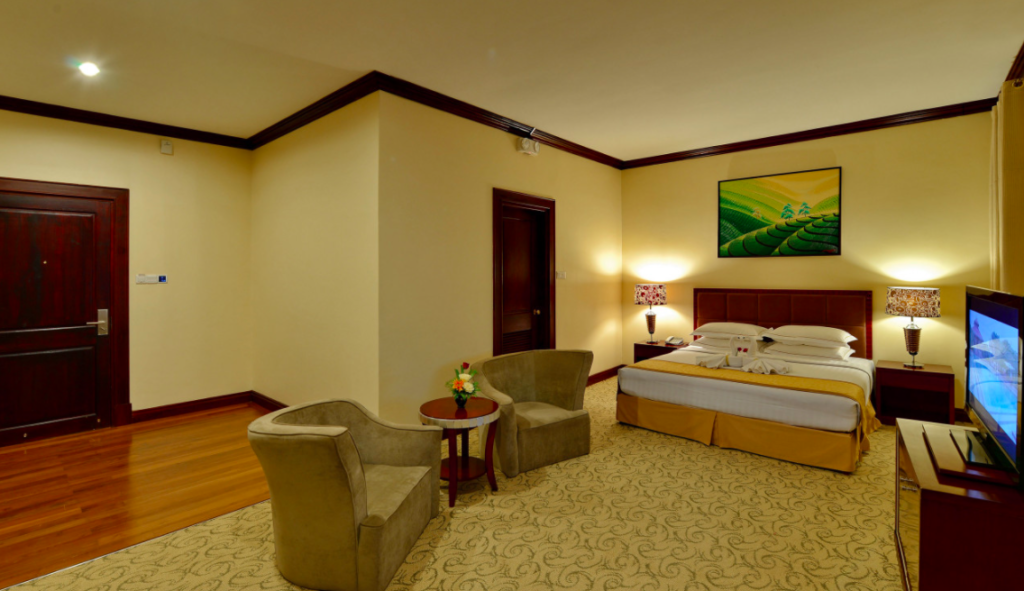
What To Do in Naypyitaw
Uppatasanti Pagoda is open from 5am until 10pm daily. Admission is free of charge, but parking costs 500 kyat. The Naypyitaw Water Fountain Garden is open between 9am and 9pm daily except Sunday. Entrance fee is 700 kyat (US$0.46). I was unaware at the time of my first visit, but Myanmar’s State Parliament Building is open to visitors. In order to put in a request, contact a travel agency. Five days notice required, but give as much time as possible. Even my hotel concierge had difficulty contacting someone to arrange a tour on my behalf during my second visit to Naypyitaw. The National Museum is open Tuesday to Sunday from 930am-430pm. Foreign admission is 5,000 kyat (US$3.33).
Other attractions include the Gems Museum, open 930am-4pm daily, but closed on Monday. Admission 5,000 kyat. The massive Defense Services Museum is free to the public. It is a must-see for any fan of military history or equipment. Passport required. Can’t make it to every single attraction in Myanmar? The National Landmark Garden is a 400-acre Myanmar-in-miniature park. Every noteworthy sight in the country is represented here. 15,000 kyat (US$10) admission includes a one hour tour by motorized golf cart.
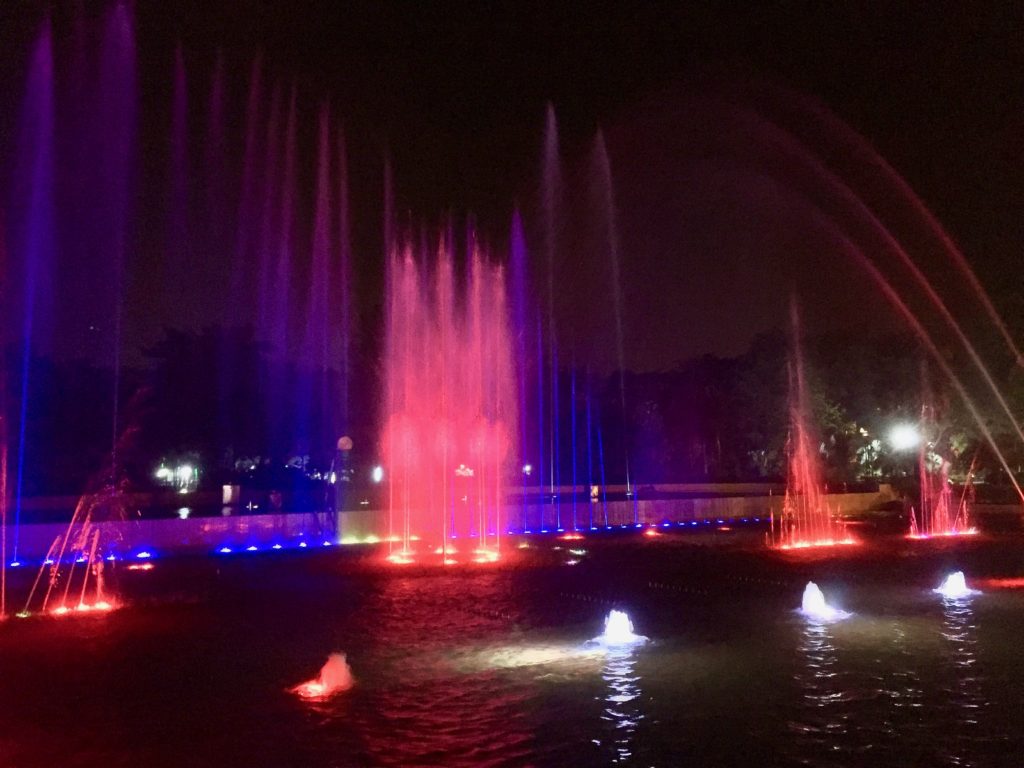
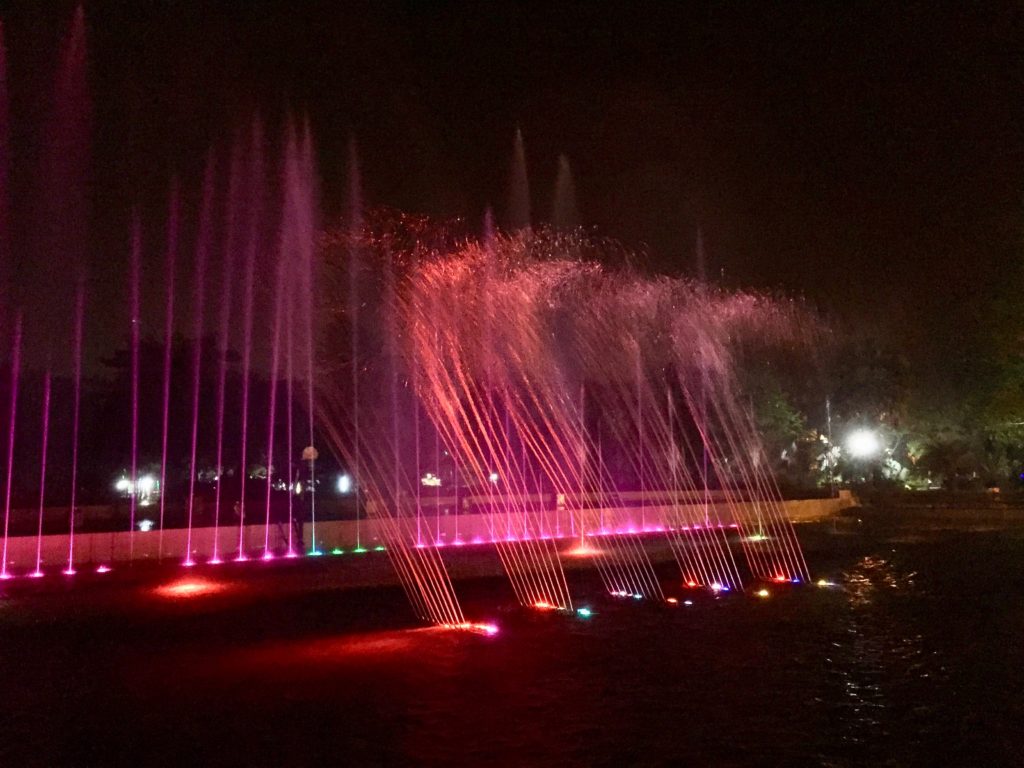
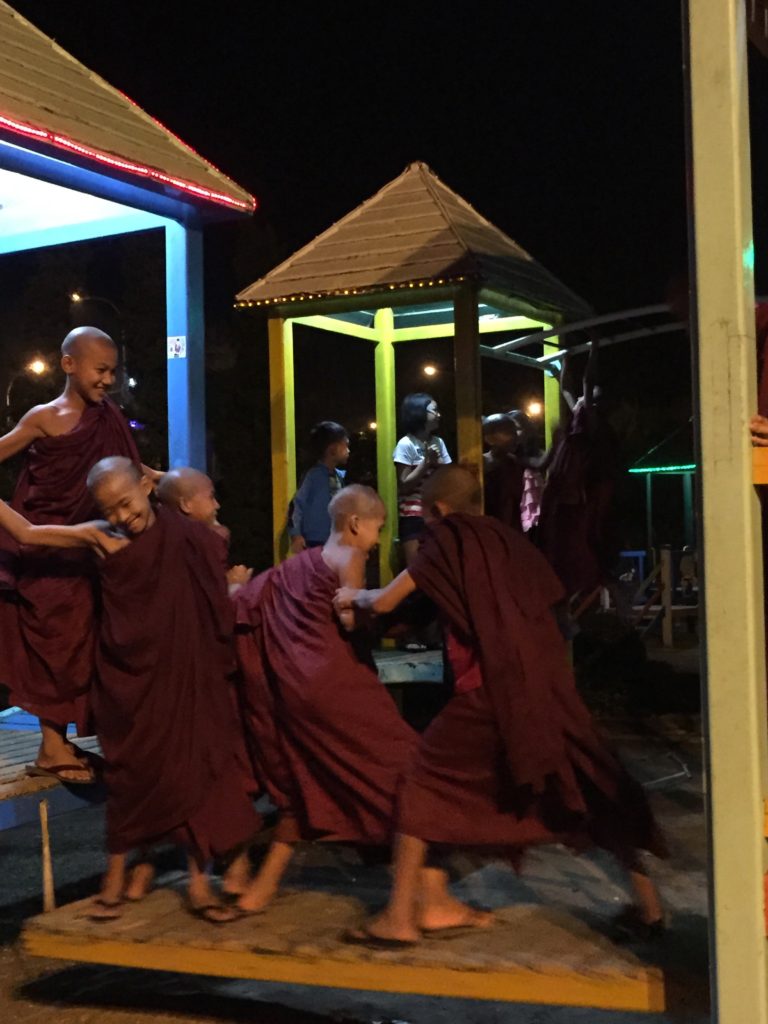
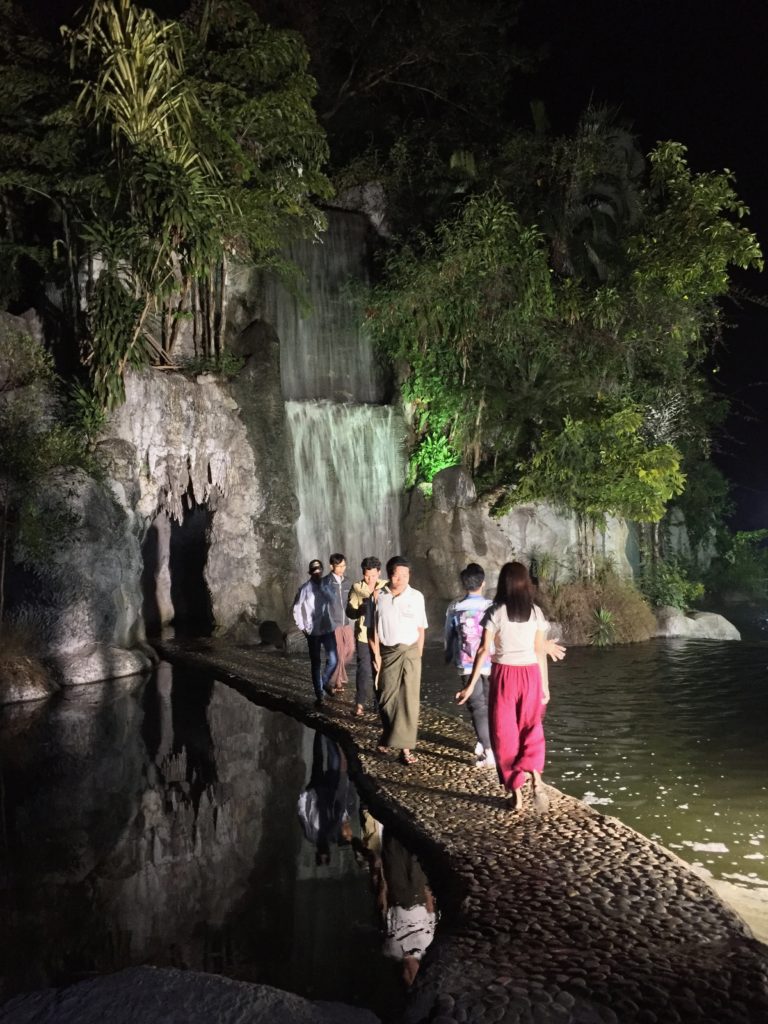
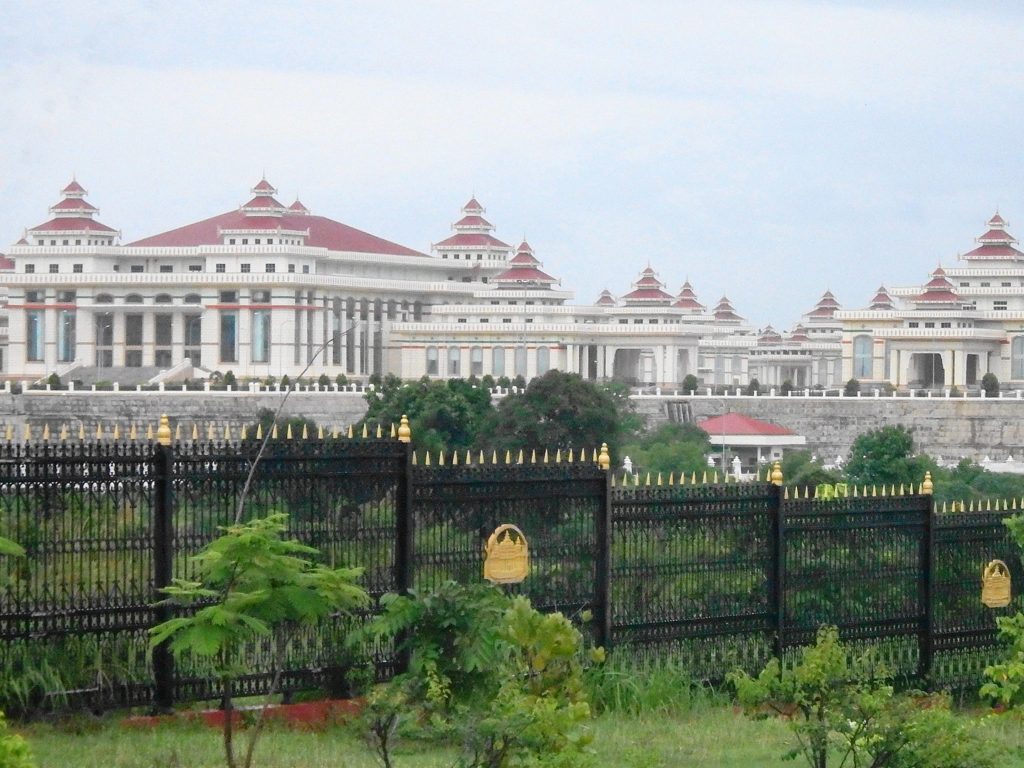
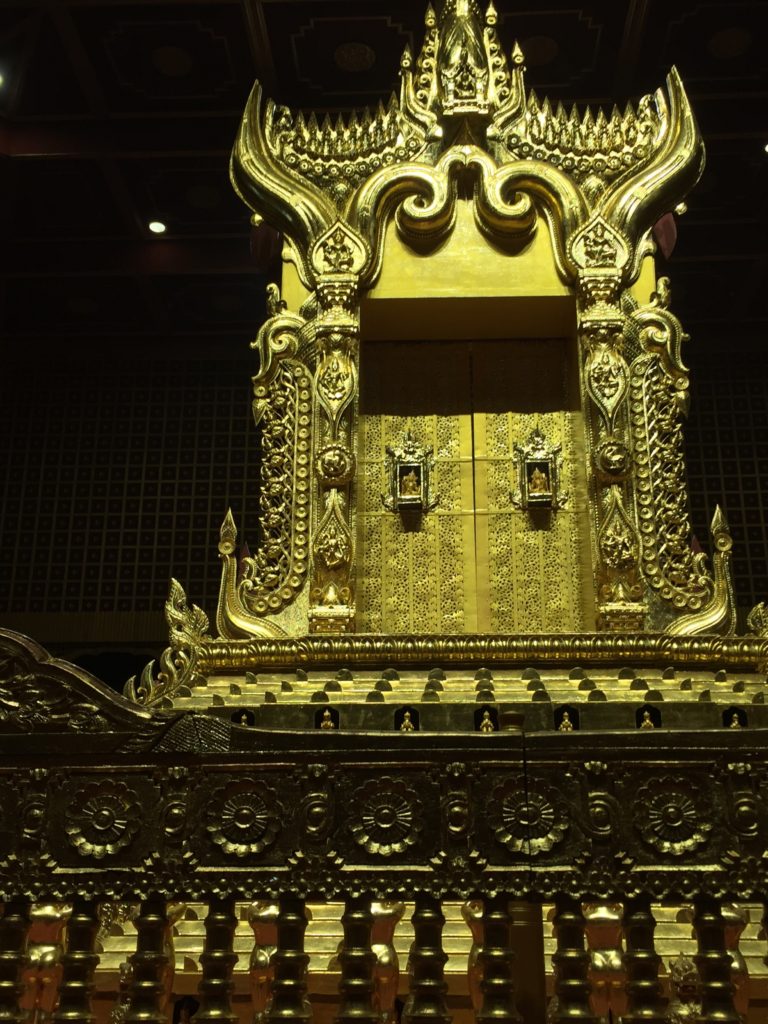
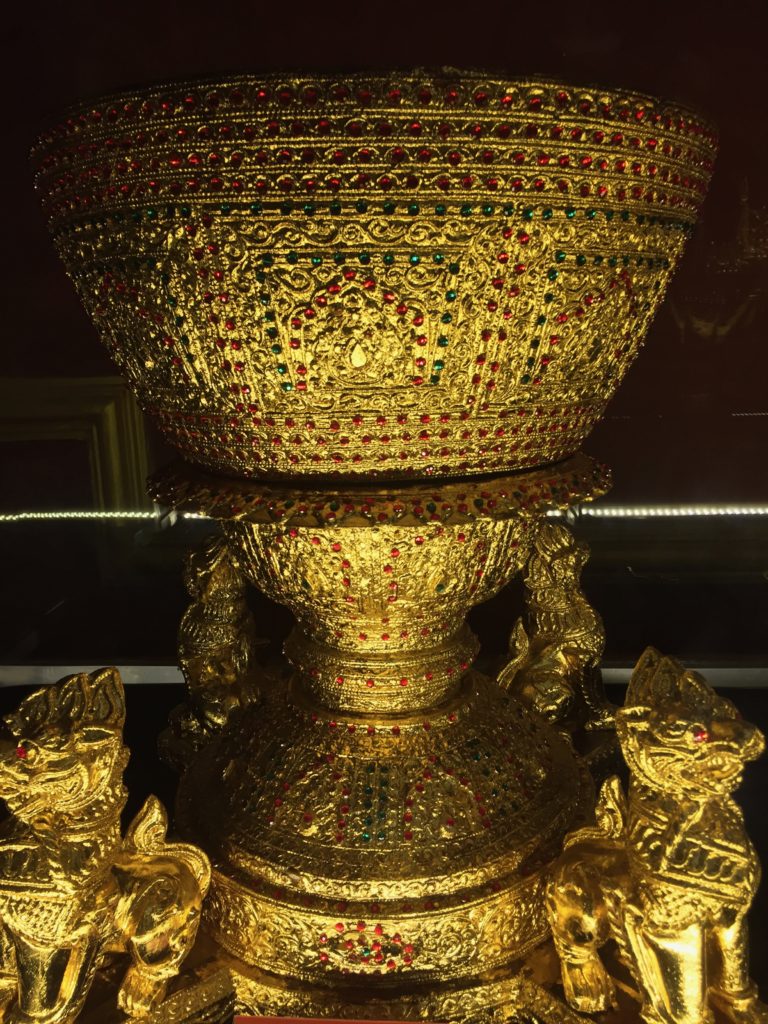
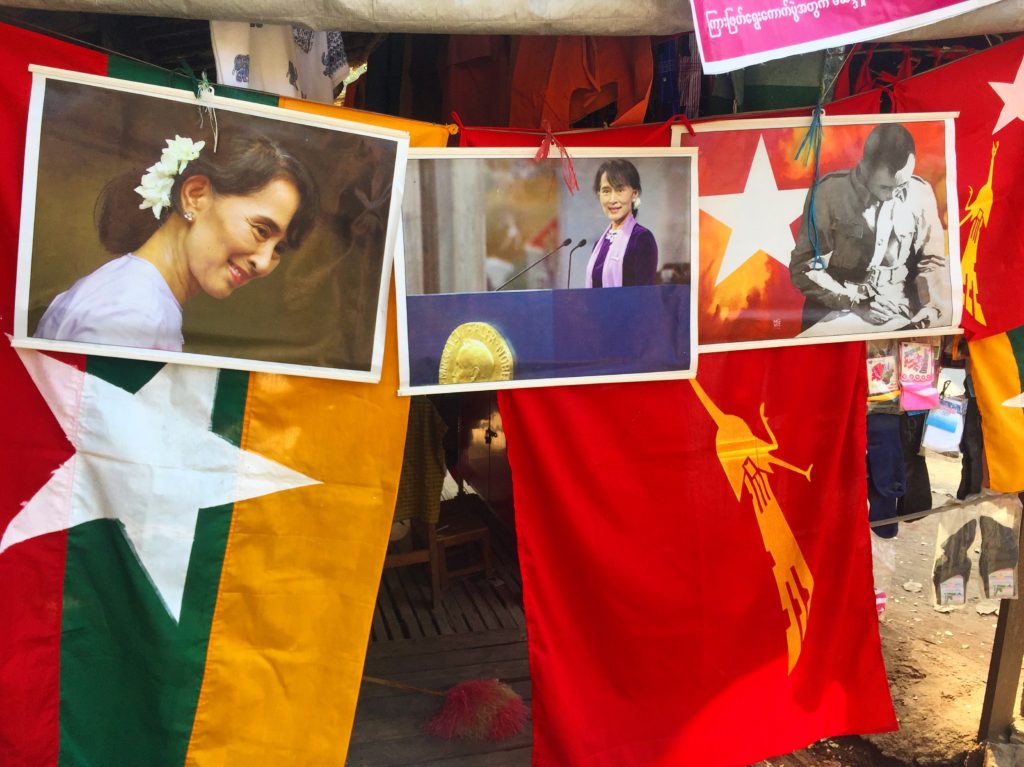

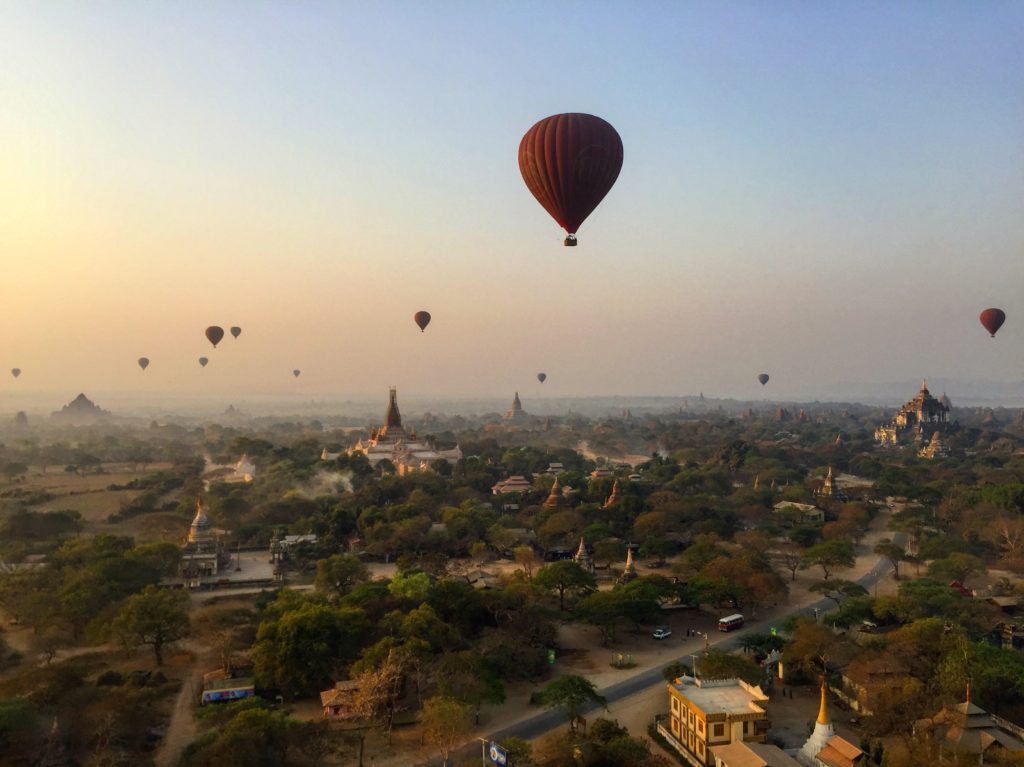
Pingback: Yenangyaung | Myanmar | Lei Thar Gone | No Guidebooks
Definitely need to add this place to a future itinerary! The more I hear about it, the more intriguing it is… it hurts to think about the elephants though :’(
Fantastic read as usual – love your work!
Aww, thanks Peta!
It is one peculiar city, eh? Very convenient for a stop too. I’m simultaneously surprised/not surprised more visitors don’t bother. More space for the rest of us!
How things change. I pass the Naypyidaw in bus on the way to Mandalay. It was 2009 i think and the city was off limit for tourist. I was shocked by highways as the rest of the roads in the country were more less pothole roads. I am looking forward to go back.
Indeed. Exploring Myanmar back in 2009 would have been something. Luckily most of the country remains free of tourists, so plenty of discoveries still to be made.
Hope you make it back again soon.
Woo-hoo! Fabulous post! I am now inspired to leave my beautiful but sterile hotel and walk the road less travelled…..well in this case, not walk, and I have to see that highway! Thank you!
Ahh, thanks very much Julie. Glad it proved inspiring and/or helpful. I’d love to hear your impressions, so feel free to chime in down the road.
Enjoy your stay!